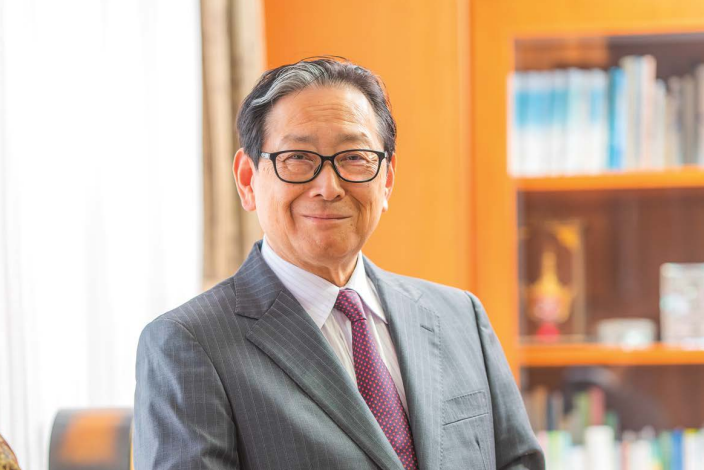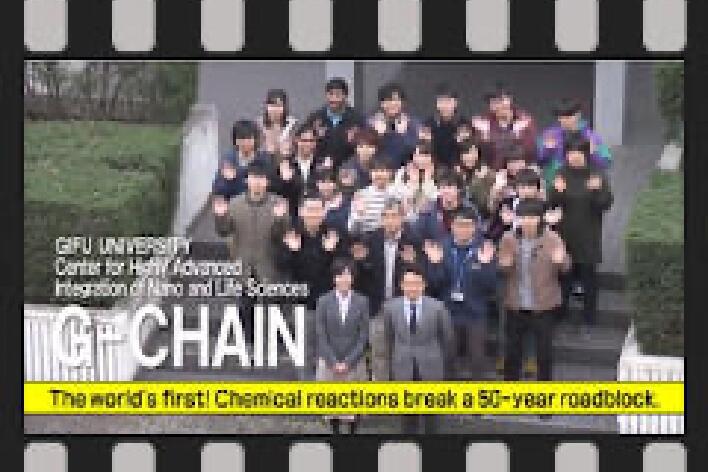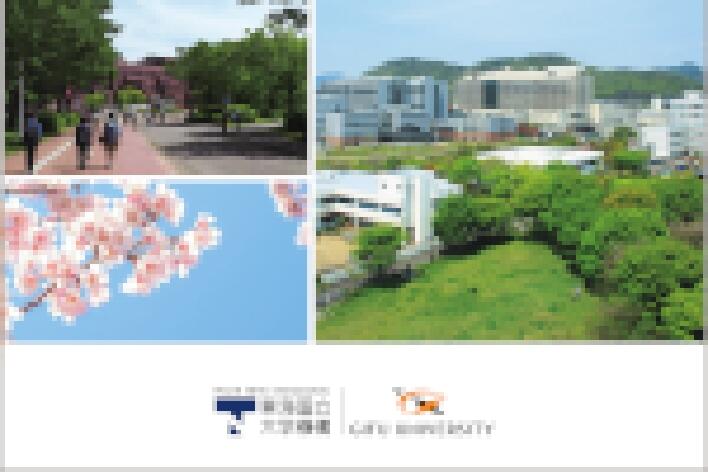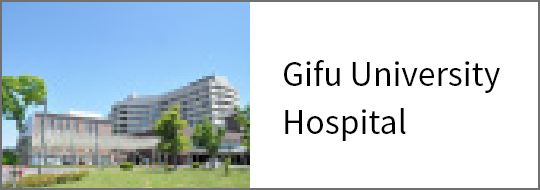First in Japan to be established on university grounds! Opening a Museum of Infrastructure featuring full-sized models of bridges, etc.
*Information related to faculty members/students and graduate schools at Gifu University here are all that of the time of interviewing.
Infrastructure Museum
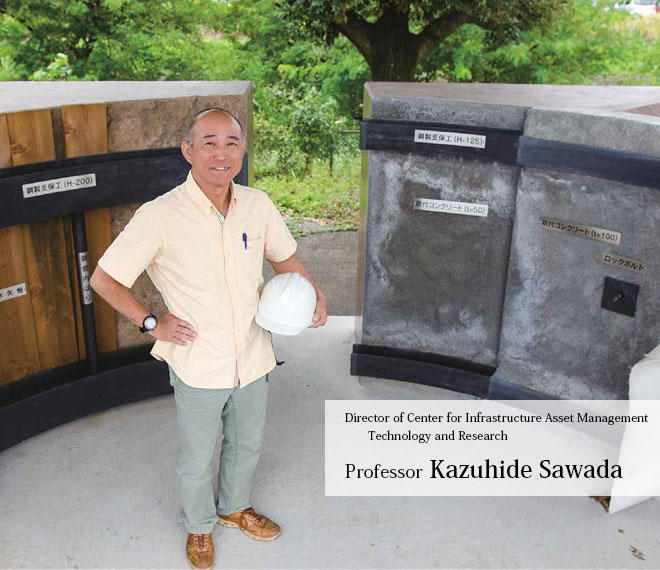
Installing models that teach using comparisons between old and new construction methods.

Gifu University opened its Infrastructure Museum in August 2017.
In a corner of the parking area beside the main gate, we have installed a concrete bridge, a steel bridge with the steel reinforcement and a model of a tunnel sliced to show its internal structure. Through models that replicate the actual size of their subject, viewers can learn about their mechanisms and structures and the construction methods of the past. The aim is to learn the ability to respond to various issues on infrastructure that occur in society. In the summer of 2018, we completed a model replicating the embankment used for roads.
Over half a century has passed since roads, bridges and other infrastructures were constructed throughout the country during the period of high economic growth. As the population decline accelerates, maintaining and managing an aging infrastructure is a topic requiring urgency. But those who built the infrastructure and worked during the high-growth period are now in retirement age. The engineers who will perform maintenance in the future will need to maintain bridges, tunnels and roads even without any experience in new construction. Some infrastructure has been constructed with different methods to those used today, so there is a pressing need to increase engineers for maintenance with proper technical skills who understand the mechanism of tunnels, bridges and other works from that time. To meet these requirements, the full-sized models at the Infrastructure Museum incorporate many construction methods dating from 1950s to today. For example, the tunnel model presents both the old method of supporting the excavated face with steel support and concrete lining and the latest method where it is reinforced in place with shotcrete and lock bolts, and it has been built to allow people to understand their differences between two methods.
At the ceremony of opening the Infrastructure Museum in August 2017, more than 220 engineers and researchers from Gifu University and beyond attended. Many people have come to view the museum. The number of visitors has already reached 1,200. Gifu University also uses the museum in experiments with the models, and it serves as a safe and invaluable laboratory for students to get real experience in measuring structures and other tasks. In these days, students are proficient at studying at school, but they tend to have little practical experience in running around in nature. Because of this background, almost all the students do not have a good sense of scale for structures. In such circumstances, to feel real-sized models frequently has great meaning in raising human resources to maintain and manage infrastructure.

The tunnel model (right of photo) has been made using the sheet piling method used until the early 1980s and the NATM method, which is the main method used now, and it allows students to compare the differences between the two structures when learning.
Nurturing excellent civil engineers through the ME development course.
 The Infrastructure Museum is also used in the infrastructure maintenance expert (ME) development course conducted by Center for Infrastructure Asset Management Technology and Research, which is affiliated with the Faculty of Engineering, Gifu University. The ME development course is an educational program exclusively for a working members of society that aims to develop engineers who can inspect, diagnose and also assess infrastructure. The purpose of this course is to have and maintain high quality infrastructure by learning the same contents deeply by both the staff of government agencies and the engineers from construction industries together. This is the 11th year of the project and 444 people have qualified as ME up to today.
The Infrastructure Museum is also used in the infrastructure maintenance expert (ME) development course conducted by Center for Infrastructure Asset Management Technology and Research, which is affiliated with the Faculty of Engineering, Gifu University. The ME development course is an educational program exclusively for a working members of society that aims to develop engineers who can inspect, diagnose and also assess infrastructure. The purpose of this course is to have and maintain high quality infrastructure by learning the same contents deeply by both the staff of government agencies and the engineers from construction industries together. This is the 11th year of the project and 444 people have qualified as ME up to today.
It is very difficult to maintain all existing infrastructures by given budget for public projects. Moreover, as can be seen from recent attention to marginal villages, there are also regions that are likely to lose their entire resident population in near future. In ME development course, we seek to have students learn the perspective of selecting infrastructure that really should be maintained and using it effectively rather than caring all the structures.
The ME qualification is already recognized to some extent in civil engineering and construction industry in Gifu Prefecture. Now, we want to establish a position of ME where the first thing people say is "Let's call a ME" when something wrong for infrastructure. Additionally, efforts to nurture ME have also begun in Ehime, Yamaguchi, Niigata and other areas in the last five years, and we are trying to broaden ME network throughout Japan.
What is an infrastructure maintenance expert (ME)?
 The infrastructure maintenance expert (ME) is an engineer with comprehensive skills relating to the maintenance of roads and other infrastructures. They are recognized within Gifu Prefecture through collaboration between the relevant government agencies and the industry. A qualification of ME is acquired by passing an examination after taking ME development course held in Gifu University. ME development course is provided as a four-week intensive program, and students acquire extensive knowledge through 80 sessions of lectures, demonstrations and on-site practical lessons on topics including "Bridge design and tunnels," "Bridge maintenance," and "Foundations and slopes." The feature of this course is that technical staff from government and engineers from the construction industry learn the same contents. In 2010, being qualified as ME was added as a criterion that gives additional credits when bidding on public works projects in Gifu Prefecture, in a change introduced on trial as a benefit of qualifying as a ME. Following a two-year trial, the change was made permanent from 2012.
The infrastructure maintenance expert (ME) is an engineer with comprehensive skills relating to the maintenance of roads and other infrastructures. They are recognized within Gifu Prefecture through collaboration between the relevant government agencies and the industry. A qualification of ME is acquired by passing an examination after taking ME development course held in Gifu University. ME development course is provided as a four-week intensive program, and students acquire extensive knowledge through 80 sessions of lectures, demonstrations and on-site practical lessons on topics including "Bridge design and tunnels," "Bridge maintenance," and "Foundations and slopes." The feature of this course is that technical staff from government and engineers from the construction industry learn the same contents. In 2010, being qualified as ME was added as a criterion that gives additional credits when bidding on public works projects in Gifu Prefecture, in a change introduced on trial as a benefit of qualifying as a ME. Following a two-year trial, the change was made permanent from 2012.

